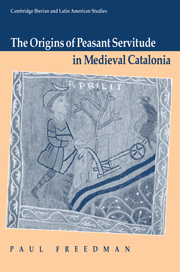Book contents
- Frontmatter
- Contents
- List of tables
- Preface
- List of abbreviations
- Map 1 Densities of Remença households at the end of the Civil War
- Map 2 Catalan comarcas and principal towns
- Map 3 Pyrenees and pre-Pyrenees
- 1 Introduction: medieval serfdom and Catalonia
- 2 Enduring characteristics of rural Catalonia
- 3 The free peasants of the ninth to eleventh centuries
- 4 Changes in the status of peasants: late twelfth and early thirteenth centuries
- 5 Catalan servitude in the thirteenth century
- 6 Effects of the Black Death
- 7 Peasant agitation and civil war, 1388–1486
- Conclusion: origins of Catalan servitude
- Appendix 1
- Appendix 2
- Appendix 3
- Appendix 4
- Bibliography
- Index
1 - Introduction: medieval serfdom and Catalonia
Published online by Cambridge University Press: 06 January 2010
- Frontmatter
- Contents
- List of tables
- Preface
- List of abbreviations
- Map 1 Densities of Remença households at the end of the Civil War
- Map 2 Catalan comarcas and principal towns
- Map 3 Pyrenees and pre-Pyrenees
- 1 Introduction: medieval serfdom and Catalonia
- 2 Enduring characteristics of rural Catalonia
- 3 The free peasants of the ninth to eleventh centuries
- 4 Changes in the status of peasants: late twelfth and early thirteenth centuries
- 5 Catalan servitude in the thirteenth century
- 6 Effects of the Black Death
- 7 Peasant agitation and civil war, 1388–1486
- Conclusion: origins of Catalan servitude
- Appendix 1
- Appendix 2
- Appendix 3
- Appendix 4
- Bibliography
- Index
Summary
This book investigates how peasants in a European region came to be serfs during the high Middle Ages. Although Southern Europe is thought to stand apart from the model of what used to be called “classic lands of feudalism,” Catalonia, a Mediterranean principality, experienced a severe form of lordship that so limited the freedom of peasants as to resemble what used to be thought more characteristic of the Loire, Thames and Rhine regions. In the northern and eastern parts of Catalonia, an area known beginning in the thirteenth century as “Old Catalonia,” peasants were subject to hereditary restrictions on movement off tenures, to degrading levies on marriage and inheritance incidents, and were placed under a largely arbitrary seigneurial jurisdiction. Catalan agrarian history offers two puzzles to the observer approaching it within a comparative European framework: (1) how a pioneer society of free agricultural settlers in the tenth century could have become a substantially servile population by the thirteenth century, and (2) how serfdom was overthrown by a revolt in the fifteenth century that stands as the unique example of a successful medieval peasant uprising. Catalonia was wealthy, commercially successful and politically expansive during the eleventh to fourteenth centuries. It had a strong central administrative tradition and numerous privileged towns. Yet this realm, in apparent contrast to its neighbors (the rest of Iberia, Languedoc and northern Italy), experienced a paradoxical oppression of its formerly free peasantry, and later the formal abolition of serfdom through an alliance between kings and peasants.
- Type
- Chapter
- Information
- Publisher: Cambridge University PressPrint publication year: 1991



